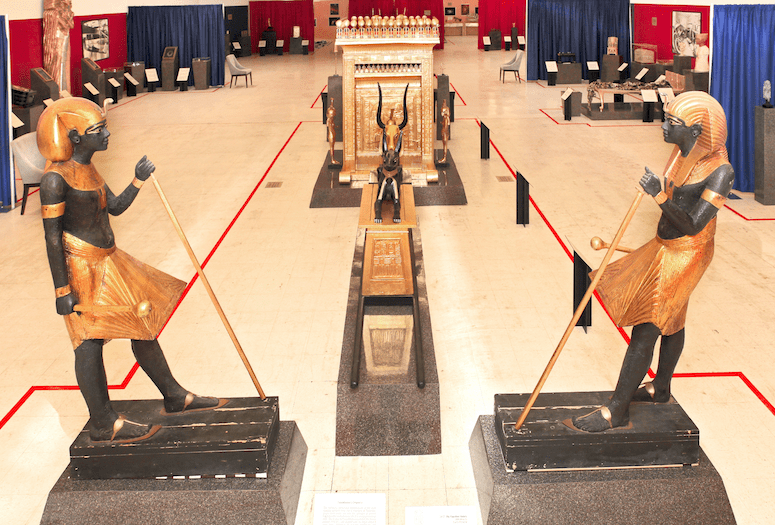
A modest strip mall at the corner of Highway 111 and Date Palm Drive is an unlikely place for King Tutankhamun’s golden chariot and the skull of a T-Rex, but Alberto Acosta and Joe McCabe are making it work. The Museum of Ancient Wonders, the Coachella Valley’s newest cultural attraction, opened Oct. 26, showing a portion of Acosta’s extensive collection of replicas of Egyptian antiquities and dinosaur fossils, along with artistic recreations of African masks representing 3,500 years of tribal ritual and mysticism.
The museum’s name comes from a statement made by Howard Carter, the British archaeologist and Egyptologist who discovered Tut’s tomb in 1922, following years of searching and excavation. As the story goes, when Carter held up a candle to peer through a small hole in a door leading to the tomb, his benefactor, Lord Carnarvon, asked if he could see anything. Carter replied, “Yes, wonderful things.”
The original tomb artifacts are on their last world tour before taking up permanent residence in the Grand Egyptian Museum in Cairo, expected to open next year. If you missed the exhibition’s 2018 stop in Los Angeles, you can get a glimpse of Tut’s world through reproductions of golden thrones, tutelary goddesses, guardian statues, unguent jars, ebony game boards, and jewelry. His mummified corpse and death mask are represented – even his court sandals, inlaid with the faces of his enemies so the young ruler could trample them with every step.
Acosta acquired the objects from artisans at the Pharaonic Village in Egypt and spent two decades packaging them into traveling exhibitions for museums around the country. As executive director, he’s an enthusiastic tour guide, pointing out subtleties and explaining the circumstances of Tutankhamun’s short life and mysterious death.
• READ NEXT: Discover How Alberto Acosta’s Background Led Him to the Museum Business.
Large wall-mounted photographs show the tomb as it looked when Carter’s team entered. Furniture, tools, and garments were piled in haphazard stacks like a disheveled storage unit on a Hollywood backlot. Seeing the pharaoh’s possessions in context, accompanied by a custom soundtrack composed by Acosta, help overcome the incongruity of being wedged between the Big Lots and Bambino’s Pizzeria in downtown Cathedral City.

The location isn’t meant to be a permanent home, just a sample of Acosta’s vision. He and McCabe, who volunteers as development director, wrangled 7,400 square feet of empty retail space that they cleaned, painted, and renovated. Using a bit of stagecraft – Acosta spent 33 years in Broadway and community theater – the team hits a realistic middle ground. There’s enough visual stimulation and educational heft to satisfy visitors now, while offering potential funders a glimpse of what the museum could be in an upgraded setting.

More than 120 replicas of Tutankhamun artifacts take up the majority of floor space, while the back section hosts a portion of Acosta’s paleontological collection, including casts of dinosaur skeletons, skulls, brains, claws, and eggs from the Mesozoic Era, known as the Age of Reptiles. Over the next year, he’ll rotate out some of those fossils to focus on human origins, such as a cast of “Lucy,” the partial skeleton of an Australopithecus afarensis female. The original “Lucy” is considered to be 3.2 million years old and kept in a climate-controlled safe at the National Museum of Ethiopia, with a plaster facsimile on display.
Acosta’s full collection of fossils, artifacts, masks, and photographs spans more than 370 objects. He estimates it would take 25,000 square feet to display them all, and he’d like another 10,000 square feet to host traveling exhibitions from National Geographic and the Smithsonian Institution. His focus for the next year is to raise money to build the infrastructure; obtain a larger site, possibly accommodating a discovery center aligned with STEM curriculum (science, technology, engineering, and math); hold tours and events for local schools and businesses; and enhance the collection with more specimens. He and McCabe secured nonprofit status earlier this year and have been actively recruiting members and donors.

Mary Madison, a semi-retired healthcare executive who lives in Palm Springs, is one of the museum’s supporters, along with her spouse, Nancy Dobrozdravic. While out walking their dogs, the couple met McCabe, who told them about the museum. “I thought it was wonderful,” Madison says. “It would be a real cultural asset to the Coachella Valley. Their whole idea and concept just seemed to be a great complement to all the other museums.” She likes the quality of the replicas and overall thematic organization, showing the links between life’s earliest forms and later human development.
Madison volunteers as a math tutor for elementary students – “Of course, they love dinosaurs” – and says she’s pleased to have a new entertainment option for houseguests.
Expanding the region’s offerings for residents and tourists is a driving force behind the Museum of Ancient Wonders. It’s why Acosta and McCabe have worked to bring the entire collection together.
“This is just the beginning,” Acosta says. “The valley deserves to have something of this scope and nature to remind people that it’s not just about modern technology and computers, and modernism and contemporary art. This is the context for how we live our lives today. It’s important to revisit history. We need to use history to guide us to the future.”

Museum of Ancient Wonders, 69028-B E. Palm Canyon Drive, Cathedral City, 442-268-5004; moaw.org.
• READ NEXT: 49 More Things to Do in November.